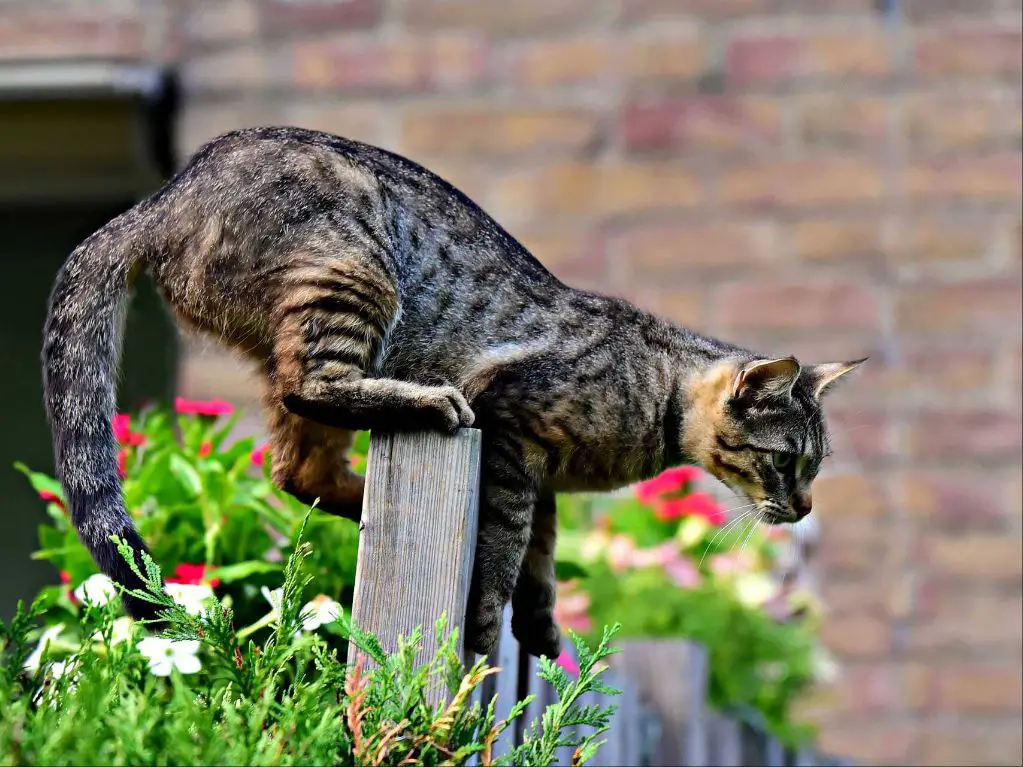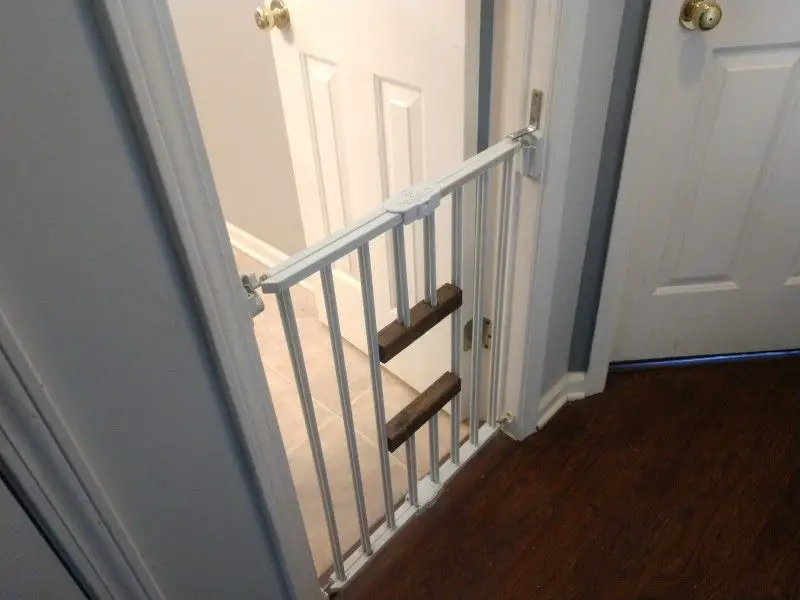Understand Why Cats and Dogs May Not Get Along

Cats and dogs have very different territorial instincts that can lead to antagonistic interactions. Cats are more solitary and territorial, with each cat maintaining distinct boundaries in the home and outside (Source). Dogs are pack animals that are less concerned with territory. The prey drive instinct in many dogs sees cats as something to be chased, while cats see dogs as predatory threats.
Cats rely on being able to perch up high and hide to feel safe. The larger size and direct approach of dogs seems very threatening. Dogs want to investigate new animals they encounter, and their direct staring and invasions of space make cats feel unsafe. These natural instincts can lead to fearful or aggressive reactions when cats and dogs interact (Source). Understanding the root causes of this antagonism is key to managing it successfully.
Keep Your Dog Leashed Outside
One of the most important things you can do to keep cats away from your dog is to keep your dog leashed when outdoors. Don’t let your dog roam free in your yard or neighborhood, as this can allow your dog to chase or harm cats in the area.
Be sure to keep your dog securely leashed, using a non-retractable leash, whenever you take them for walks. Avoid walking in areas where there are lots of stray or outdoor cats. Even the best trained dog can get overstimulated and go after a cat if given the chance. Keeping your dog leashed prevents this situation.
Leashes give you control over your dog when outdoors. It takes only a split second for a dog to injure or kill a cat once pursuing it. Don’t give your dog that opportunity. Leashes keep everyone safer. According to a 2016 study, over 15% of dog attacks on cats resulted in significant injury.
Secure Your Yard
You can secure your yard against cats by installing physical barriers, deterrents such as motion sensors, and removing things that attract stray cats.
To start, install a secure, solid fence around your yard that is at least 6 feet tall to prevent cats from jumping over. Bury part of the fence underground or add rollers to the top so cats cannot dig under or climb over (Source). You may also want to cover any gaps in the bottom or sides of the fence. An enclosed backyard prevents cats from entering and keeps your dog contained.
In addition to fencing, using motion activated sprinklers or spray deterrents when a cat is detected can startle and scare them away. The PetSafe SSSCAT Spray is an effective cat repellent. You can also try sprinkling cayenne pepper or lemon peels around your yard’s perimeter.
Finally, eliminate outdoor food sources, water bowls, and potential hiding places like bushes or gaps under porches that would attract stray cats. Remove any cat waste or scents in your yard too. Keeping your yard free of what draws cats will help deter them from coming back.
Train Your Dog
One of the best ways to teach your dog to ignore cats is through training. You can use positive reinforcement techniques to teach your dog the ‘leave it’ command, which tells them not to chase or interact with cats. To teach ‘leave it’:
Have your dog on a leash and give them a treat. While they are eating the treat, present another treat in your hand and say “leave it.” Once they stop paying attention to the treat in your hand, praise them and give them the treat you originally gave them. Repeat this process, eventually working up to presenting treats on the floor and instructing them to ‘leave it.’ Reward them with treats and praise when they listen.
You can practice the ‘leave it’ command when your dog is around cats. When your dog spots a cat but does not react, reward them with treats and praise. This reinforces ignoring the cat. You can also distract your dog with obedience commands or toys when cats are present. Keep them focused on you rather than the cat.
With regular positive reinforcement training, your dog will learn that ignoring cats and listening to you leads to rewards. Be patient and consistent, and your dog can be trained to peacefully coexist with cats. For more training tips, check out this guide: How to Train Your Dog to Ignore Cats.
Keep Cats Out of Your Yard

There are several effective methods to keep outdoor cats from intruding into your yard and interacting with your dog. Using cat repellents is one of the simplest solutions. Homemade cat repellent sprays using natural ingredients like vinegar, citrus juices, garlic, and peppermint oil can create scents cats dislike (DIY Make Your Own Cat Repellent Spray). Spray repellents around the perimeter of your yard and any areas cats frequent.
Eliminating food sources like exposed trash or pet food that may attract cats is also important. Keep trash receptacles sealed and store all pet food indoors. You can also scare cats away from your yard with deterrents like water guns or loud noises if you catch them entering. Repeatedly scaring them away will teach cats to avoid your property.
Keep Your Dog Inside
One of the best ways to prevent issues between your dog and neighborhood cats is to keep your dog inside when unattended. While many dogs enjoy spending time outdoors, leaving dogs unattended in the yard comes with risks. According to veterinarians at Vetstreet, leaving dogs unattended for long periods can lead to problematic behaviors like excessive barking, anxiety, and hyperactivity.
Instead of leaving your dog in the yard, bring them inside when you are away or cannot supervise them. You can walk your dog on a leash to let them relieve themselves as needed. But keeping your dog indoors prevents problematic interactions with cats roaming the neighborhood.
If a cat comes into your yard while your dog is outside, bring your dog inside right away. Leaving them alone together can lead to injuries or fighting. By bringing your dog inside, you remove the opportunity for conflict and keep both animals safe.
While your dog may like being outside, keeping them indoors when unattended protects them and avoids creating issues with neighborhood cats. Provide plenty of enrichment indoors and take your dog on regular leashed walks for bathroom breaks.
Create Physical Barriers

One of the most effective ways to keep cats and dogs separated is by creating physical barriers in your home. This involves restricting access between rooms and areas using gates, doors, and other dividers. Here are some tips:
Block the dog door so the cat can’t enter rooms where the dog is. Install a sturdy barricade or cover over the flap. You can also get an electronic dog door that only opens for your dog’s microchip or collar tag.
Use baby gates to restrict access between rooms. Position them in doorways or hallways so the dog and cat have their own separated zones. Make sure the gate is high enough that the dog can’t jump over it.
Keep cats in an upstairs area while confining dogs to the main floor. Close doors to staircases and use gates so they can’t access each other’s domains. Provide litter boxes upstairs for the cats.
Feed dogs and cats in separate rooms with the door closed. This prevents conflict over food and allows them to eat in peace.
At night, keep dogs in their crates or your bedroom while cats roam freely outside. This allows the cat space while the dog sleeps.
With strategic barriers, you can give cats and dogs their own safe spaces in the home. Supervise all interactions until they reliably get along. Reinforce calm behavior on both sides by rewarding them.
Diffuse Tensions
When introducing a new cat to a resident dog, it’s important to diffuse any tensions that may arise. Here are some tips:
Give cats elevated escape routes so they can get away from the dog if needed. Place cat trees, shelves, and furniture around the room that the cat can easily jump on top of. This will give the cat a safe place to retreat.
Allow cautious introductions between the dog and cat. Keep the dog on a leash and let the cat approach slowly, on its own terms. Don’t force them to interact. Go at the pace the cat is comfortable with.
Reward peaceful behavior between the animals. Give treats to both the dog and cat when they are calmly co-existing in the same space. This positive reinforcement will promote good interactions.
With patience and proper introductions, tensions between dogs and cats can be minimized. Allow them to get used to each other’s smells before face to face meetings. Making sure both animals feel safe and have escape routes is key to diffusing tensions.
Sources:
https://www.animalhumanesociety.org/resource/how-introduce-dog-and-cat
https://resources.bestfriends.org/article/how-introduce-dog-cat
Try Anxiety Vests

Anxiety vests like the ThunderShirt apply gentle pressure which can have a calming effect on some dogs. The light pressure gives dogs a sense of security similar to being held or hugged. ThunderShirts and similar vests may help reduce your dog’s reactivity and stress around cats.
When introducing ThunderShirts, monitor your dog closely. Make sure the vest fits properly but is not too tight or restrictive. Use the vest for short periods at first while supervising your dog. Follow recommendations on gradually increasing wear time. Do not leave an anxiety vest on an unsupervised dog.
While ThunderShirts are safe for most dogs, they may cause irritation on some dogs with short hair. Discontinue use if you notice signs of distress or skin irritation. ThunderShirts are not a cure for serious anxiety issues but can be one tool in managing mild to moderate reactivity and stress.
When to Seek Help
If your dog continues to exhibit aggression and chasing towards cats despite your best training efforts, it may be time to seek professional help. An experienced dog trainer or behaviorist can assess your dog’s behavior and provide customized training techniques to curb the cat chasing instinct (1). Medication may also help in severe cases, under the guidance of your veterinarian. Anti-anxiety medications can reduce a dog’s prey drive and reactivity towards cats (2).
As a last resort, you may need to consider rehoming your dog if the behavior does not improve. However, be aware that surrendering a dog with known cat aggression issues makes adoption much more difficult. Responsible shelters will disclose the dog’s history, which limits options (3). Thoroughly research potential adopters or rescues willing to take on an aggressive dog. Make sure your dog goes to an experienced home prepared to manage the risks (4). Rehoming an aggressive animal should not be taken lightly, but in some cases it may be better for the welfare of all pets involved.
With patience, proper training, and in some cases medication, many dogs can learn to co-exist peacefully with cats. But if issues persist over an extended time, do not hesitate to enlist the help of professionals. They can help guide your next steps, whether training, medical intervention, or the difficult decision to rehome your dog.

